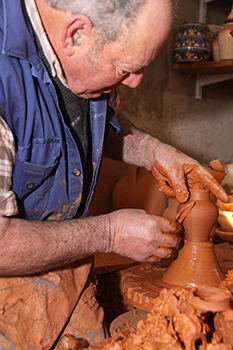 |
Pottery and clay work, these two forms and its trajectories are quite analogous in Portugal, and traditional pottery of Viana do Alentejo is no exception. The method of handling clay and its consequent modelling to the traditional forms appears to be quite identical: one would go to the clay extraction site to acquire the feedstock, which would be transported to the pottery workshop, where the clay was cleaned and prepared to be worked on the wheel. After the piece was moulded, it was baked.
The bowl1 and the pot are the most emblematic tools of Viana do Alentejo’s traditional pottery. Considering the utility of Viana do Alentejo’s ceramics, we can infer that some of the forms are inspired from other cultures that left their marks on our territory: the “moringue” (clay jug with two bottlenecks) is probably an import from India and the Americas; the “alguidar”, the “aljofaina” (set of utilitarian ceramics composed of a rounded bowl and respective jug), the “almotolia” (a glazed vase commonly used for olive oil, with a wide bulge and narrow mouth) from the Arabs; from the Greeks and the Romans we have got many other forms. In Viana do Alentejo, as evidenced by the pieces found in Monte da Romeira by José Oliveira Caeiro, in the context of the Levantamento Arqueológico do Alentejo (Archaeological Survey of Alentejo), the roots of pottery are based on the Roman period, as is indicated by their forms and their intrinsic utility.
In the 1960s there were about 22 workshops in Viana do Alentejo with the purpose of production. At that time, having as background the spaces of pottery shops, the teaching was done in a generational way.
The establishment of the pottery school Médico de Sousa came to alter the generational structure of the teaching of this craft, providing knowledge and training to all who wanted it. Founded on 28th October 1893 this workshop/school, where practically all the processes related to the crafts of the potter, the crockery baker and the ceramics painter were taught, was constituted as one of the first industrial schools of the country. Linked to the “União Vinícola e Oleícola do Sul” (Wine and Olive Union of the South), the first Portuguese cooperative wine cellar, it was given the name of School Médico de Sousa as a sign of gratitude and respect for the enterprise of the entire Sousa family in favour of the village and the Municipality of Viana do Alentejo .
The decoration of the Viana do Alentejo crockery, beginning only in 1982, and made through pressing, incision, or even painted on the surface of the object, follows two distinct strands: either based on the geometric ornament, with simple and complex combinations of various forms and shapes, or in an ethnographic, descriptively figurative theme. A superficial analysis of the colour palette still used today allows us to infer that, in this context, Viana do Alentejo crockery finds its first experiences in Júlio Resende, who taught at School Médico de Sousa between 1949 and 1951, on which period he bought the colours in Chambres house, during his trips to Oporto.
1 - In Portuguese “alguidar”, a bowl wider than tall, whose mouth has a bigger diameter than the bottom.

 Abrir Lista
Abrir Lista MUNICÍPIO DE VIANA DO ALENTEJO
MUNICÍPIO DE VIANA DO ALENTEJO